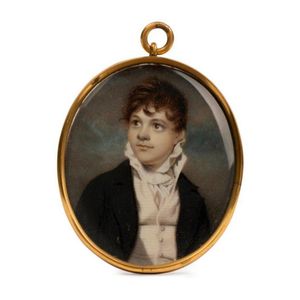Portrait Miniature of William Henry Betty by G. Engelheart
You must be a subscriber, and be logged in to view price and dealer details.
Subscribe Now to view actual auction price for this item
When you subscribe, you have the option of setting the currency in which to display prices to $Au, $US, $NZ or Stg.
- Verso - Verso is the "back" side of a sheet of paper, art work, coin or medal. The front side is "recto".
- George Iii - George III (1738 - 1820) was King of Great Britain and Ireland from 1760 to 1820.
- Gilding - Gilding is a method of ornamentation whereby a thin sheet of gold metal is applied to items made of wood, leather, ceramics, glass and silver for decorative purposes.
For furniture including mirrors, the sheet of gold is usually applied over a coating of gesso. Gesso is a mixture of plaster of Paris and gypsum mixed with water and then applied to the carved wooden frames of mirrors and picture frames as a base for applying the gold leaf. After numerous coats of gesso have been applied, allowed to dry and then sanded a coat of "bole", a usually red coloured mixture of clay and glue is brushed on and allowed to dry, after which the gold leaf is applied. Over time parts of the gilding will rub off so the base colour can be seen. In water gilding, this was generally a blue colour, while in oil gilding, the under layer was often yellow. In Victorian times, gilders frequently used red as a pigment beneath the gold leaf.
Metal was often gilded by a process known as fire gilding. Gold mixed with mercury was applied and heated, causing the mercury to evaporate, the long-term effect of which was to kill or disable the craftsman or woman from mercury poisoning. The pursuit of beauty has claimed many victims, not the least of which were the artists who made those pieces so highly sought after today.
This item has been included into following indexes:
-
miniatures
- 18th century 90
- 19th century 357
- Georgian 239
- portrait and other 1,223
Visually similar items

Portrait miniature of a gentleman in a blue coat, 9 x 7 cm (frame)

A Georgian portrait miniature of a gentleman by Thomas Hazlehurst, the finely painted oval ivory panel depicting a gentleman in a blue jacket, signed lower right T.H. Having a glazed hair section to the reverse and Bristol blue glass within a rose gold fra

A late Georgian miniature locket, gold cased open locket set with a hand painted miniature of a gentleman on ivory with plaited hair in rear compartment, fitted box, 70 x 50 mm (including bail)

A Georgian miniature of man in blue coat on ivory, gilt oval frame on later ebonised frame, 7 x 6 cm
